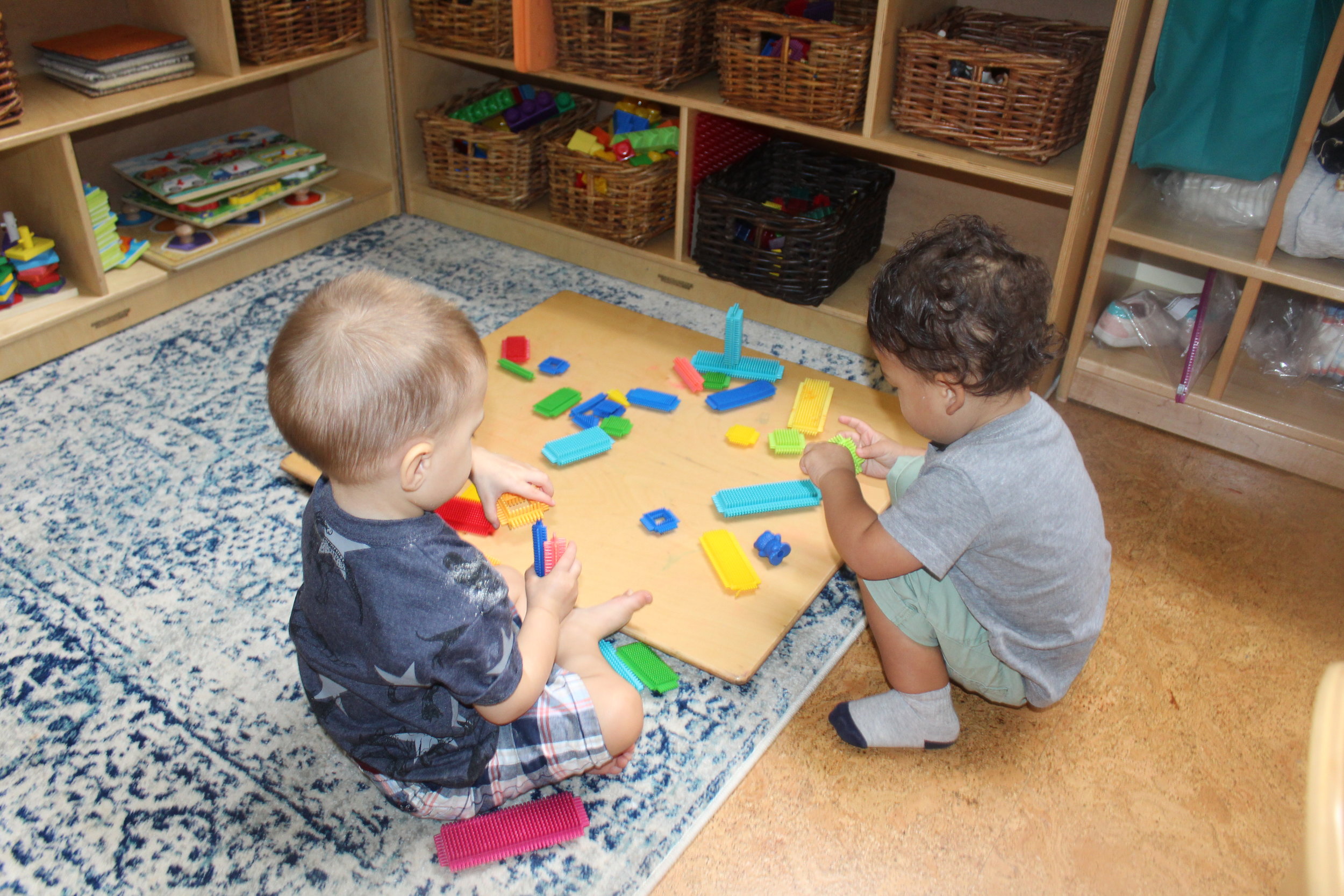Each child learns at a different pace, and demonstrates their preferences as they interact with materials. Their disposition with clay, play dough, and paint is different with each child. Their interests allow us as teachers to create activities and build a community of learners. The children are gradually learning their peers and teachers names, sharing, taking turns, and respecting each others space.
The curriculum for the year is Social-Emotional. It will have different sections. For example, our first focus will be on Self Management/Self-expression. It will include: How do I care for myself?, How do I become resilient? How do I understand, acknowledge and express my feelings? and What makes me special?
Our School Wide Area of Research is Paint!
When a child engages in a painting project, does his/her emotional disposition change? Does a child having a difficult morning suddenly relax once painting is introduced?
How does painting help children connect with their peers?
As a child gains control over their fine motor capabilities, how does it affect the story/verbalization of the painting?
Painting allows children to explore, discover and express themselves as they maneuver their paintbrush or hand to create their unique strokes.
This week we had our Back to School Picnic! Meeting parents and parents meeting each other enables us as a community to learn and understand each other. As a classroom community I welcome all my new and returning parents to Buckle My Shoe.
During the week the children have learned and engaged in different activities, sang and listened to songs, and many stories. Among the song we sang were:
Mr. Sun
ABC
What’s the Weather?
Where is Thumbkin?
Where is red? ( A song about colors, using a glove)
Watermelon
The Wheels on the Bus (favorite)
Head and Shoulders……
5 little speckled frogs (finger puppet)
5 little ducks
Old McDonald had a Farm (finger puppet)
5 little Monkeys
Baby Shark
The highlights of the week:
Art:


The children explored Bubble Wrap Painting! They maneuvered their hands and fingers differently as they engaged in the activity. They are simultaneously working on their fine motor skills and learning about color and texture.

Train Track Prints




Exploring Tempera Paint:
Art is the process of creating and experimenting. The soothing process of painting encourages children to generate different ways to explore painting. The children chose different colors to paint. They patted the paintbrush lightly on the paper and instantaneously made more prominent movements by going side by side. A variety of muscle groups and physical and mental skills, including strength, dexterity, vision, and motor planning- the ability of the brain to organize and carry out movements, are developing in young toddlers. As they grip the tool, they will have enough control to create artistic masterpieces, using different strokes.



The children are painting bathroom paper rolls for a special activity that I will be introducing next week, Pom Pom Drop! This fun and interactive activity promote one-to-one correspondence, counting, color recognition, size (small and big), fine motor skills, and geometry (round shape). Recycling activities introduce young children that the materials used are part of our environment. They can build life-long environmentally friendly habits early on.




Today we explored Powder Paint. To use the paint for art, we had to add water. The consistency of the paint will depend on the amount of water used. We used more instead of less to create a thick consistency. The texture and color are different from tempera and finger paint. The children seemed interested as they explored the paint. We will continue investigating and exploring another color next week.



Revisiting Clay.


Teacher: “What are we making today?”
Leo: “Play dough!”






Clay is very versatile, and there are so many ways toddlers can play and experiment with it. Clay gives them the opportunity to be creative and learn about texture, shape, and form.
Leela manipulated the clay by using her hands and fingertips and adorned her creativity with pipe cleaners.
Teacher: “Leela, what are you making?”
Leela: “Cake!”


Tissue Paper Bleeding: We experimented using water and tissue paper. The children placed strips of tissue paper in a square container of water. After, several minutes we noticed the water changed from clear to green and red color. The children looked curious and amazed.


Circle Time:


During circle time we gave the children a bean bag to hold, squeeze and pat as we sang good morning to each child. When we stopped, we asked the child to pass the bean bag to the next child. The children are learning color, shape, texture, sharing, and taking turns.
Leo Shaftel asked, “What’s inside?”
Teacher: “I don’t know! What do you think is inside?
Leo Shaftel: “Bean!”



Sensory Scarfs: Scarf plays are beneficial for young toddlers. Children begin to learn about the world around them through their senses, and as they mature, children learn through movement and exploration. The teacher articulated the colors in English and Spanish. Scarves are colorful, tactile, easy to grab, and fun to manipulate.







Every day before we go to the gym, the children line up against the wall or sit. We sing one song, then enter the gym.
Manipulative Toys:



Using a colander and pipe cleaners is a way for children to work on their fine motor skills and hand-eye coordination. The objective is for the children to try to stick the pipe cleaners through the holes. They continuously maneuvered the pipe cleaner as they maintained focus on holding and inserting it. They lowered their fingers closer to the colander hole and soon saw that they could stick the pipe cleaner. They seemed curious as they explored. The children that participated demonstrated focus and determination as they manipulated the materials.
It is essential to allow children the opportunity to explore and find their technique to complete the task. This activity promotes, concentration, work on their small muscles of their fingers, imagination, and creativity.




Blocks:

Using unit blocks to measure our height!
Their height is part of their identity. As they develop, they grow taller, and they each grow differently. We began measuring their height using unit blocks. Each child will lie in a horizontal position, and on their side will place some unit blocks. We will all count how many blocks are needed to determine his/her height. They are also building knowledge as they count and learn the shape that is being used to identify their stature. We will measure their height in September, January, and May.
We are almost done measuring all the children.







Picnic Day at Buckle My Shoe!
1A and Infant 1B joined 1B
















Teacher: “James, what are you building?”
James: “A castle!”
Teacher: “Who is going to live in the castle?”
James: “Me!”
James continues to add blocks to his structure. Blocks are used as construction toys and playing with toys is one of the many ways children learn about the world around them. Blocks help foster developmentally appropriate skills: motor skills, problem-solving, eye-hand coordination, language, social/emotional, spatial, and divergent skills are some examples. Construction play hones skills that are beneficial to the young developing minds. Each skill helps children to strive as they are learning while playing. Children’s imagination and creativity increase as they manipulate each piece.

Block play provides hours of fun for children as well as enhancing the development of basic skills. Bristle Blocks stimulates children’s imagination and creativity by connecting and building. Children can mesh together and pull apart the flexible pieces. They develop fine motor skills and dexterity. These blocks promote color and shape recognition.
Nate appears interested and focused as he connects the bristle blocks. He manipulates and attempts to mesh two thin bristle blocks. He moves his hands up in the air and started to make airplane sounds. Then, they came apart and tried to mesh them together again and said, “It’s broken, mama!”

